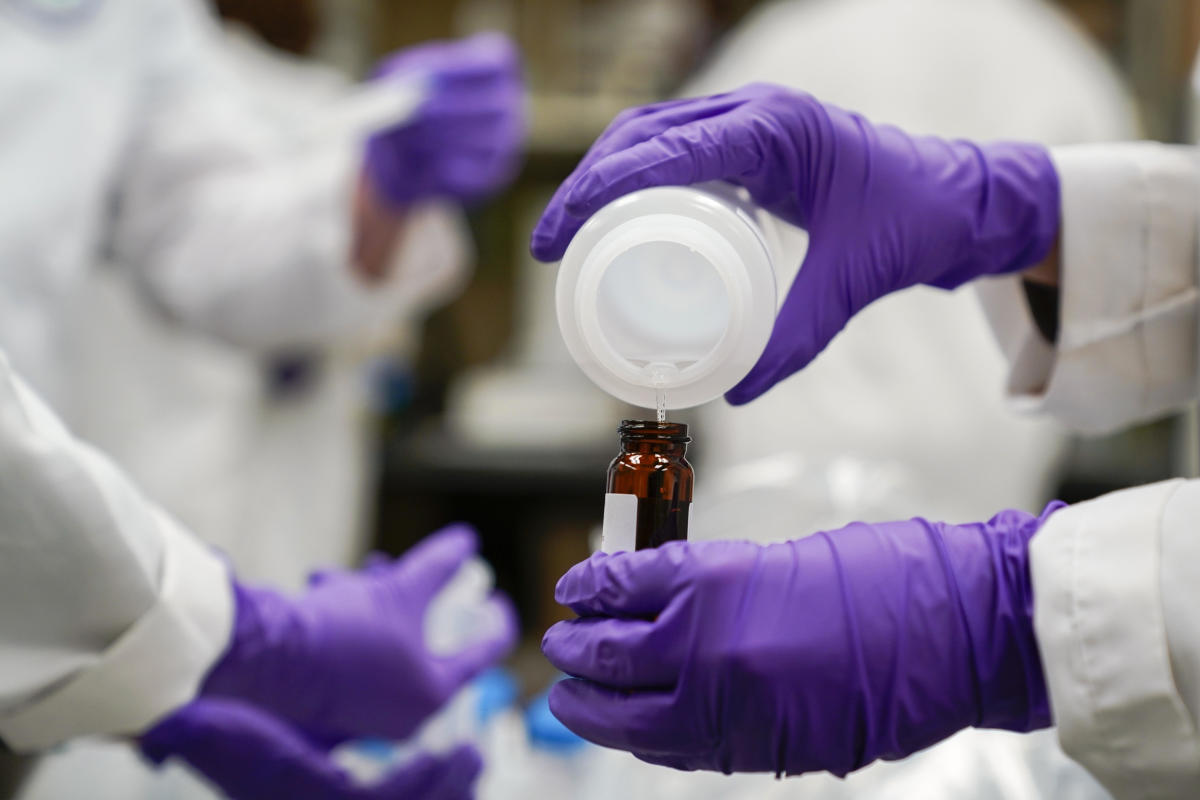
The Environmental Protection Agency has established national limits for six types of per- and polyfluoroalkyl substances (PFAS) in drinking water, with PFOA and PFOS limited to 4 parts per trillion and three additional PFAS restricted to 10 parts per trillion. PFAS are associated with health risks such as certain cancers, heart disease, and reproductive issues. Companies phased out PFOA and PFOS in the mid-2000s, but they still persist in the environment. Eleven states in the U.S. already have regulatory standards for PFAS in drinking water.

A new study has revealed that PFAS (perfluoroalkyl and polyfluoroalkyl substances), known as forever chemicals, are present in surface and groundwaters globally at levels exceeding many international regulatory limits. Used in consumer products since the 1950s for their nonstick and water-repellent properties, PFAS are difficult to break down in the environment. In the US, nearly half of tap water is contaminated with these chemicals, with 31% of groundwater samples surpassing proposed EPA thresholds and 70% surpassing Health Canada standards. PFAS have been linked to health issues like cancer, obesity, and thyroid disease.

Per- and polyfluoroalkyl substances (PFAS or PFASs) are a group of synthetic organofluorine chemical compounds that have multiple fluorine atoms attached to an alkyl chain. An early definition, from 2011, required that they contain at least one perfluoroalkyl moiety, –CnF2n+1–. Beginning in 2021, the Organisation for Economic Co-operation and Development (OECD) expanded their terminology, stating that "PFASs are defined as fluorinated substances that contain at least one fully fluorinated methyl or methylene carbon atom (without any H/Cl/Br/I atom attached to it), i.e., with a few noted exceptions, any chemical with at least a perfluorinated methyl group (–CF3) or a perfluorinated methylene group (–CF2–) is a PFAS."According to the OECD, at least 4,730 distinct PFASs that contain at least three perfluorinated carbon atoms are known. The United States Environmental Protection Agency's (EPA) toxicity database, DSSTox, lists 14,735 unique PFAS chemical compounds, while PubChem lists more than 6 million. The fluorinated surfactants or fluorosurfactants subgroup has a fluorinated "tail" and a hydrophilic "head" and are thus considered surfactants. These are more effective at reducing the surface tension of water than comparable hydrocarbon surfactants. They include the perfluorosulfonic acids, such as perfluorooctanesulfonic acid (PFOS), and the perfluorocarboxylic acids like perfluorooctanoic acid (PFOA).Many PFASs were used in the mid-20th century in products and on materials due to their enhanced water-resistant properties, such as within Teflon or aqueous film forming foam. Only since the start of the 21st century has the environmental impact and toxicity to human and mammalian life been studied in depth. PFOS, PFOA and other PFASs are commonly described as persistent organic pollutants or "forever chemicals" because they do not break down via natural processes. Residues have been detected in humans and wildlife, prompting concern about impacts on health. According to the National Academies of Sciences, Engineering, and Medicine, PFAS exposure is linked to increased risk of dyslipidemia (abnormally high cholesterol), suboptimal antibody response, reduced infant and fetal growth, and higher rates of kidney cancer.Health concerns related to PFASs have resulted in numerous litigations (see Timeline of events related to per- and polyfluoroalkyl substances). PFAS producers such as 3M, Chemours, DuPont and Corteva have reached billion dollar agreements to settle claims against them. The use of PFAS is regulated in several parts of the world, with some plans to phase them out entirely from products.

The Food and Drug Administration (FDA) in the United States has successfully phased out per- and polyfluoroalkyl substances (PFAS), toxic chemicals previously used in food packaging to prevent oils and water seepage. PFAS, linked to health issues like cancer and birth defects, were voluntarily removed by food manufacturers starting in 2020, following concerns about their potential harm to humans. The completion of this phase-out eliminates the primary source of dietary exposure to PFAS from food packaging. PFAS can still be found in other sources like drinking water, meat, and dairy products.

3M, a chemical manufacturer, will begin payments to many U.S. public drinking water systems as part of a multi-billion-dollar settlement over contamination with potentially harmful compounds used in firefighting foam and consumer products. The settlement, approved by the U.S. District Court in South Carolina, will involve payouts through 2036 ranging from $10.5 billion to $12.5 billion based on additional contamination findings. The compensation addresses pollution with per- and polyfluorinated substances (PFAS), known for their persistence in the environment and health risks including liver damage and cancer. PFAS have been detected in drinking water nationwide.

Perfluorooctanoic acid (PFOA; conjugate base perfluorooctanoate; also known colloquially as C8, for its 8-carbon chain structure) is a perfluorinated carboxylic acid produced and used worldwide as an industrial surfactant in chemical processes and as a material feedstock. PFOA is considered a surfactant, or fluorosurfactant, due to its chemical structure, which consists of a perfluorinated, n-heptyl "tail group" and a carboxylate "head group". The head group can be described as hydrophilic while the fluorocarbon tail is both hydrophobic and lipophobic.PFOA is one of many synthetic organofluorine compounds collectively known as per- and polyfluoroalkyl substances (PFASs).PFOA is used in several industrial applications, including carpeting, upholstery, apparel, floor wax, textiles, fire fighting foam and sealants. PFOA serves as a surfactant in the emulsion polymerization of fluoropolymers and as a building block for the synthesis of perfluoroalkyl-substituted compounds, polymers, and polymeric materials. PFOA has been manufactured since the 1940s in industrial quantities. It is also formed by the degradation of precursors such as some fluorotelomers. PFOA is used as a surfactant because it can lower the surface tension of water more than hydrocarbon surfactants while having exceptional stability due to having perfluoroalkyl tail group. The stability of PFOA is desired industrially but is a cause of concern environmentally.The primary manufacturer of perfluorooctanesulfonic acid (PFOS), the 3M Company (known as Minnesota Mining and Manufacturing Company from 1902 to 2002), began a production phase-out in 2002 in response to concerns expressed by the United States Environmental Protection Agency (EPA).: 2 Eight other companies agreed to gradually phase out the manufacturing of the chemical by 2015.: 3 By 2014, EPA had listed PFOA and perfluorooctanesulfonates (salts of perfluorooctanesulfonic acid, PFOS) as emergent contaminants:PFOA and PFOS are extremely persistent in the environment and resistant to typical environmental degradation processes. [They] are widely distributed across the higher trophic levels and are found in soil, air and groundwater at sites across the United States. The toxicity, mobility and bioaccumulation potential of PFOS and PFOA pose potential adverse effects for the environment and human health.: 1

This timeline of events related to per- and polyfluoroalkyl substances (PFASs) includes events related to the discovery, development, manufacture, marketing, uses, concerns, litigation, regulation, and legislation, involving the human-made PFASs. The timeline focuses on some perfluorinated compounds, particularly perfluorooctanoic acid (PFOA) and perfluorooctanesulfonic acid (PFOS) and on the companies that manufactured and marketed them, mainly DuPont and 3M. An example of PFAS is the fluorinated polymer polytetrafluoroethylene (PTFE), which has been produced and marketed by DuPont under its trademark Teflon. GenX chemicals and perfluorobutanesulfonic acid (PFBS) are organofluorine chemicals used as a replacement for PFOA and PFOS.PFAS compounds and their derivatives are widely used in many products from water resistant textiles to fire-fighting foam. PFAS are commonly found in every American household in products as diverse as non-stick cookware, stain resistant furniture and carpets, wrinkle free and water repellant clothing, cosmetics, lubricants, paint, pizza boxes, popcorn bags and many other everyday products.

The Wisconsin state Assembly passed a bill to allocate $125 million for municipalities and landowners affected by forever chemicals, known as PFAS. These chemicals have been linked to health issues and are found in various products. Despite the Senate's approval in November, Gov. Tony Evers opposes the bill due to restrictions limiting the Department of Natural Resources' enforcement abilities. Key areas affected by PFAS contamination in Wisconsin include Madison, Marinette, and Green Bay. The bill aims to fund testing and studies on PFAS but faces opposition from environmental advocates and the governor, potentially leading to the funds remaining unused.

Residents of New Milford, Connecticut have filed a lawsuit against Kimberly-Clark, the parent company of Kleenex, for releasing toxic PFAS chemicals into the air and water from its plant in the town, causing health risks and lowering property values. PFAS chemicals are hard to break down and have been linked to cancer and infertility. The lawsuit seeks damages, water filters installation, and health monitoring for residents. Thousands of lawsuits have been filed against manufacturers of PFAS chemicals, prompting federal regulatory action by the EPA.

PFAS or PFASs are per- and polyfluoroalkyl substances, a large class of synthetic chemicals.PFAS or PFASS may also refer to:Phosphoribosylformylglycinamidine synthase, an enzymePersonal fall arrest system, in workplace safetyPhiladelphia Female Anti-Slavery Society

Perfluorooctanesulfonic acid (PFOS) (conjugate base perfluorooctanesulfonate) is a chemical compound having an eight-carbon fluorocarbon chain and a sulfonic acid functional group and thus a perfluorosulfonic acid. It is an anthropogenic (man-made) fluorosurfactant, now regarded as a global pollutant. PFOS was the key ingredient in Scotchgard, a fabric protector made by 3M, and related stain repellents. The acronym "PFOS" refers to the parent sulfonic acid and to various salts of perfluorooctanesulfonate. These are all colorless or white, water-soluble solids. Although of low acute toxicity, PFOS has attracted much attention for its pervasiveness and environmental impact. It was added to Annex B of the Stockholm Convention on Persistent Organic Pollutants in May 2009.

Ninety-five percent of strawberries in UK supermarkets contain PFAS, known as 'forever chemicals', linked to cancer, high cholesterol, kidney issues, thyroid disease, infertility, weakened immune system, and birth complications. PFAS is found in grapes (61%), cherries (56%), spinach (42%), tomatoes and peaches (38% each). These chemicals are used in cookware, textiles, and more and can persist in the environment and human body, raising health concerns. Campaigners urge banning 25 PFAS pesticides and supporting safer farming practices to reduce exposure to these harmful toxins.

A new database by the Norway-based PlastChem Project lists 16,000 plastic chemicals in production, with 4,200 posing significant health and environmental risks, while only 980 are regulated. Common items like blood bags, water bottles, and children's toys contain these harmful chemicals. Major concerns include PFAS linked to cancer, phthalates affecting hormones, and bisphenols disrupting the endocrine system. Lead author Martin Wagner emphasizes the need to address problematic plastic chemicals for environmental and human safety.

Polytetrafluoroethylene (PTFE) is a synthetic fluoropolymer of tetrafluoroethylene. It belongs to the per- and polyfluoroalkyl substances (PFAS)) and has numerous applications. The commonly known brand name of PTFE-based composition is Teflon by Chemours, a spin-off from DuPont, which originally discovered the compound in 1938.Polytetrafluoroethylene is a fluorocarbon solid, as it is a high-molecular-weight polymer consisting wholly of carbon and fluorine. PTFE is hydrophobic: neither water nor water-containing substances wet PTFE, as fluorocarbons exhibit only small London dispersion forces due to the low electric polarizability of fluorine. PTFE has one of the lowest coefficients of friction of any solid.Polytetrafluoroethylene is used as a non-stick coating for pans and other cookware. It is non-reactive, partly because of the strength of carbon–fluorine bonds, so it is often used in containers and pipework for reactive and corrosive chemicals. Where used as a lubricant, PTFE reduces friction, wear, and energy consumption of machinery. It is used as a graft material in surgery and as a coating on catheters.PTFE is one of the best-known and widely applied PFAS commonly described as persistent organic pollutants or "forever chemicals". Only since the start of the 21st century has the environmental impact and toxicity to human and mammalian life been studied in depth. For decades, DuPont used perfluorooctanoic acid (PFOA, or C8) during production of PTFE, later discontinuing its use due to ecotoxicological and health issues that led to legal actions. Dupont's spin-off Chemours today manufactures PTFE using an alternative chemical it calls GenX, another PFAS.

This is the first story in a series, Fighting Forever Chemicals: Women face pervasive PFAS risks . Jessian Choy had worn Thinx menstrual underwear for years before she learned they contained forever chemicals. I had always known that anything water, grease and stain resistant could have toxic PFAS chemicals in them because of my day job at the time, said Choy, who was working in San Franciscos Department of the Environment when she found this out. But, she said, my only vice at the time was ..

The Biden administration has announced a new air quality standard aimed at preventing illnesses caused by fine particulate matter in the air. The Environmental Protection Agency (EPA) stated that particulate matter, often emitted from sources such as factories, power plants, vehicles, and wildfires, is linked to serious and sometimes fatal illnesses, including heart disease, lung cancer, and chronic kidney disease. The EPA's new standard sets an annual threshold of 9 micrograms per cubic meter, which is closer to the target of 8 micrograms per cubic meter advocated by health organizations.

The Environmental Protection Agency has announced a rule that will require over 200 chemical plants in the U.S. to decrease toxic emissions that pose health risks to nearby communities, particularly targeting the largest chloroprene emissions source, the Denka Performance Elastomer Plant in Reserve, Louisiana.

The Environmental Protection Agency (EPA) has finalized a stricter standard for fine particle pollution, or soot, for the first time in twelve years. The updated National Ambient Air Quality Standards tighten limits on fine particle pollution from 12 micrograms per cubic meter to 9 micrograms per cubic meter on an annual basis. The EPA estimates that this change will avoid 4,500 premature deaths, 800,000 cases of asthma symptoms, and 290,000 lost work days in 2032. The new standard is seen as a victory for health advocates and will lead to cleaner air and healthier lives, particularly for communities of color and vulnerable populations.

The Environmental Protection Agency (EPA) has banned asbestos, a carcinogen still used in products like chlorine bleach and brake pads, under a new rule that expands regulations on toxic chemicals. The ban targets chrysotile asbestos, currently used in brake linings and gaskets, as well as in the manufacturing of chlorine bleach and caustic soda. EPA Administrator Michael Regan emphasized the significance of the ban in protecting public health and highlighted the link between asbestos exposure and diseases like lung cancer and mesothelioma. The ban aligns with President Joe Biden's Cancer Moonshot initiative.

/cdn.vox-cdn.com/uploads/chorus_asset/file/25382501/1210650853.jpg)




Yahoo! News

CBS News

Washington Post

The Verge

By MICHAEL PHILLIS

NPR

NBC

PANORA

Wikipedia

PANORA

PANORA

Wikipedia

Wikipedia

PANORA

PANORA

Wikipedia

Wikipedia

PANORA

PANORA

Wikipedia

PANORA

PANORA

PANORA

PANORA

PANORA